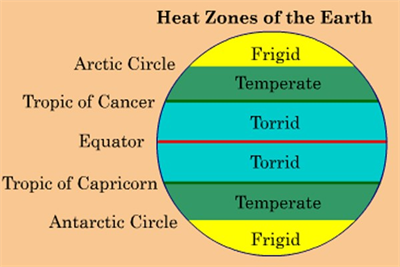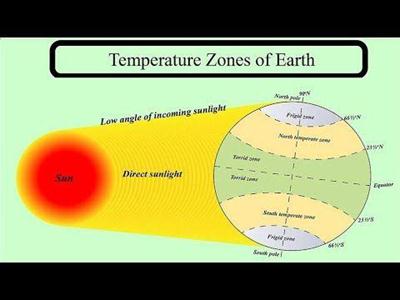
PUMPA - SMART LEARNING
எங்கள் ஆசிரியர்களுடன் 1-ஆன்-1 ஆலோசனை நேரத்தைப் பெறுங்கள். டாப்பர் ஆவதற்கு நாங்கள் பயிற்சி அளிப்போம்
Book Free DemoLatitude lines help divide the earth into different climatic zones based on the amount of heat received from the Sun.
Torrid Zone
The region from the Equator to the Tropic of Cancer\((23½°N)\) in the northern hemisphere and from the Equator to the Tropic of Capricorn\((23½°S)\) in the southern hemisphere or in other words, the region between Tropic of Cancer and Tropic of Capricorn is said to be a Torrid Zone.
- Solar radiation or Sun's rays falls vertically over this region.
- Very high average temperature.
- Therefore, this region is known as the Torrid Zone.

Temperate Zone
Northern Hemisphere: From the Tropic of Cancer \((23½°N)\) to the Arctic Circle \((66½°N) \)
Southern Hemisphere: From the Tropic of Capricorn \((23½°S)\) to the Antarctic Circle \((66½°S)\)
- The Solar radiation or Sun's rays reaches the ground slantingly (i.e. inclined)
- Moderate temperature prevails in this region. Hence, this region is called the Temperate Zone.
Frigid Zone
Northern hemisphere: From the Arctic Circle \((66½°N) \)to the North Pole \((90°N) \)
Southern hemisphere: From the Antarctic Circle \((66½°S)\) to the South Pole \((90°S)\)
- The solar radiation or Sun's rays falls at a very small angle (nearly flat) throughout the year.
- The temperature is very low and freezing. Therefore, this region is known as the Frigid Zone.
